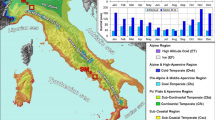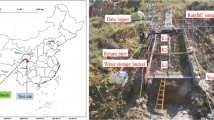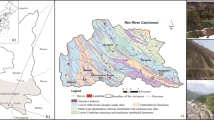Abstract
Reactivated landslides have often posed a significant hazard to human lives and properties in many regions of Indonesia. In order to mitigate the hazard, a better understanding of mechanism leading to the reactivation of landslides is necessary. For this purpose, a long-term monitoring and numerical analysis of an active landslide in a volcanic soil slope in West Java, Indonesia was conducted. Monitoring instruments consisted of jet-fill tensiometers, inclinometers, open stand-pipes, and a tipping-bucket rain-gage. The records of pore-water pressure responses of the soil slope show that a transient perched water table could develop within the shallow soil profile, and the groundwater table could rise significantly in the middle portion of the slope during heavy rainstorms. Meanwhile, the inclinometer records show the existence of a multiple sliding zone at a maximum depth of about 17 m. Based on the monitoring data, a couple analysis of seepage and slope stability was performed to evaluate the effect of rainwater infiltration on long-term stability of the slope. The numerical results indicated that the total rainfall of at least 550 mm, with intensity of more than 80 mm/day was the triggering hydrological condition for reactivation of the landslide.
Access provided by Autonomous University of Puebla. Download chapter PDF
Similar content being viewed by others
Keywords
Introduction
The role of rainfall in the stability of soil slopes is complex. Besides affecting the hydrological and geotechnical conditions of the slopes, rainfall also affects the properties of the soil itself. The changes in the hydrological condition affect the geotechnical condition of the slope, particularly by increasing the pore-water pressure in the soil. In a steep slope with a deep groundwater table, matric suctions play positive role in affecting the shear strength of the soil and thus the stability of the slopes (Rahardjo 1999).
The strength of residual soil mass may also deteriorate with time as the soil is constantly weathered. The effect of climate on the properties of the soil is not easily quantified in a short period of time. On the other hand, the role of rainfall in affecting the groundwater table, pore-water pressure and the shear strength of the soil can now be assessed with the current knowledge.
Understanding of mechanisms and conditions leading to the initiation of rainfall-induced landslides has been generally gained from field measurements and laboratory strength tests. From the results of field measurements, it is generally accepted that the rapid rise of rainfall-induced pore-water pressure is critical to the initiation of landslides (Johnson and Sitar 1990). It is typically observed that significant build up in positive pressure heads is generated in an area low on the slope (Sitar and Anderson 1992; Anderson and Thallapally 1996). However, the mechanism of pore-pressure generation differs from site to site, depending on the site hydrology and soil properties (Sitar and Anderson 1992; Tohari et al. 2004).
Reactivation of landslides have affected human lives and properties in many regions of Indonesia. The occurrences of such landslides have caused US$ 1–2 million in damages on average every year. A high occurrence of the landslides can be attributed in part to the lack of understanding of the mechanism of the landslides. As such, it is still difficult to practice an effective measure to mitigate the hazard posed by the landslides.
This paper presents the results of a long-term monitoring and numerical modelling of an active landslide to evaluate the mechanism of the landslide. The research was carried out in a volcanic soil slope in Sumedang District, West Java, Indonesia due to a prolonged landslide hazard to a major provincial road called the Cadas Pangeran road. Despite the completion of geometry correction and slope reinforcement works after a movement in 2005, tension cracks (Fig. 1) were still found to develop across the slope, indicating that the cut-slope was still in an unstable condition.
Methodology
Slope Characterization
Based on the topographical map shown in Fig. 2, and sub-surface geotechnical data, the slope profile was constructed as shown in Fig. 3. The slope profile is made up of the following soil layers of volcanic origin:
-
(a)
Medium clayey silt layer of 3.0–4.0 m thick, made up of completely decomposed volcanic breccias.
-
(b)
Loose silty sand layer of 2.0–6.5 m thick, derived from highly decomposed volcanic tuff.
-
(c)
Dense sand layer of 4.0–10.0 m thick, as the product of moderately decomposed volcanic breccias.
Soil Properties
A series of laboratory tests was conducted on soil samples obtained from each soil layer to determine the following soil properties: (1) the index properties, (2) the saturated coefficient of permeability, (3) the saturated shear strength parameters (c’, φ’), and (4) the soil water characteristic (SWC) curves. The saturated properties of the soil samples are summarized in Table 1.
Figure 3 shows the SWC curves for each soil sample measured in the laboratory using the drying path. The curves were fitted using the van Genuchten function (1980). The air-entry value (AEV) for all soil samples is approximately 10 kPa (Fig. 4).
Figure 5 shows the soil permeability functions estimated from the SWC curves using the van Genuchten equation (1980). It can be seen that the estimated soil permeability (kw) decreases by almost four orders of magnitude over the soil suction range of 100 kPa.
The shear strength functions of each soil layer were estimated from the saturated shear strength parameters and SWC curves using a method the Khalili and Khabbaz’s method (1998). The results are shown in Fig. 6. The values of φb for each soil is approximately 10° for soil suction at the air entry value.
Field Instrumentation System
Field instruments consisted of 24 jet-fill tensiometers, five open standpipes and five inclinometers and a rain-gauge. All the tensiometers were installed at five closely-spaced nests (A to E) within 5.0 m radius (Fig. 7). Each nest consisted of five tensiometers, installed at depths of 0.5, 1.0, 1.5, 2.0 and 3.0 m. The objective was t0 obtain the spatial variation of pore-water pressure responses of the slope to rainfall infiltration.
Five open standpipes and five inclinometers (see Fig. 2) were installed, up to a maximum depth of 25 m, to monitor groundwater levels and horizontal deformation of the slope, respectively. A dipmeter was used to monitor groundwater levels in the open standpipes. A portabel inclinometer probe was used to measure horizontal displacement in the inclinometers. The monitoring was manually performed every month for 2 years.
A tipping-bucket rain gauge was used to obtain site-specific rainfall data (i.e., rainfall total and intensity). The rain gauge was calibrated to measure rainfall in increment of 0.2 mm.
An automatic data acquisition system was set up to monitor the soil pore-water pressure and rainfall in real time on a continous basis. The data acquisition system consisted of the sensors, cables, data logger, and power supplies. The data logger was configured to collect data at a 5 min interval. The data were collected biweekly or monthly
Numerical Modelling
Seepage Analysis
To understand the effect of rainwater infiltration on the pore-water pressure distribution within the soil slope, the slope profile shown in Fig. 3 was subjected to a transient seepage analysis using the finite element computer program SEEP/W (Geo-Slope International Ltd 2002a). The boundary conditions were imposed using the groundwater level data obtained from the open standpipes. Zero flux conditions were assigned to the left, right and lower boundaries. An initial pore-water pressure value of -40 kPa was used. For this analysis, the hydraulic properties of each soil layer are given in Figs. 4 and 5. The transient analysis was then performed using the daily rainfall records of December 2007 to November 2008 (Fig. 8).
Slope Stability Analysis
The computer program SLOPE/W (Geo-Slope International Ltd 2002b) was used to perform a limit equilibrium analysis on the landslide investigated in this study. The stability analysis used the pore-water pressure distributions obtained from the seepage analysis as input data at each time step. The general limit equilibrium (GLE) method was used in this analysis. The shear strength parameters adopted for each soil layer are given in Table 1 and Fig. 6. The depth of critical slip surface was determined from the inclinometer records of INCL-03.
Results
Field Monitoring of Pore-Water Pressure Responses
Figures 9 and 10 show the responses of pore-water pressure at Nests A and D to rainfall events from December 2007 to January 2008, respectively. Generally, the pore-water pressures decreased with depth. Prior to the rainfall events, a minimum pore-water pressure of -40 kPa was recorded by the deepest tensiometers.
In response to the rainfall events, all tensiometers recorded the increase of pore-water pressures within the slope. However, the pore-water pressure responses in Nest A were less rapid than those in Nest D because the antecedent pore-water pressures of the near-surface soils in Nest A was higher than those in Nest D. The records of shallow tensiometers indicate that the near-surface soil profile was nearly saturated. Meanwhile, the records of deepest tensiometers in Nest A show that the rainwater did not infiltrate to a depth of 3.0 m. In other words, the infiltration of rainwater were confined within the zone of higher saturation that developed near the slope surface in this slope portion.
Field Monitoring of Slope Movement
Displacement records of inclinometer INCL-05 (Fig. 11), located at the upper part of the slope, shows a clear development of a sliding zone at a depth of 11 m, with a cumulative displacement of about 6 mm. Meanwhile, inclinometer INCL-03 (Fig. 12), located at the lower part of the slope, show sliding zones developed at depths of 5 and 17 m. Thus, the monitoring records suggest that the landslide investigated in this study is an active landslide with a multiple sliding zone.
Numerical Analysis
Pore-water pressure distributions within the slope due to rainfall events from October 2007 to November 2008 are shown in Fig. 13 for four selected days. The results show a rise of the groundwater table, especially in the middle and lower portions of the slope, and that the near-surface soils were almost saturated in response to a heavy rainfall period until March 2008 (Fig. 13a). In response to a dry period from May to August 2008, the near-surface soils became more unsaturated. However, the groundwater table still increased within the slope profile (Fig. 13b). As heavy rainfall periods started from October to November 2008, the groundwater level increased significantly, especially in the middle part of the slope. Groundwater seepage also started to develop at the slope toe (Fig. 13c)
Figure 14 shows the evolution of the factor of safety with time during the periode of rainfall infiltration from December 2007 to November 2008. The period of rainfall infiltration of October 2007 to January 2008, with a rainfall total of 710 mm and a maximum intensity of 89.5 mm/day, resulted in a significant decrease of the factor of safety from 2,07 to 1.33. The factor of safety then decreased to 1.28 during a heavy rainfall period from February to March 2008. The factor of safety decreased further to 1.16 due to the heavy rainfall of 553 mm with a maximum intensity of 87.6 mm/day in October-November 2008. This was associated with the development of groundwater seepage at the slope toe area.
Conclusions
The results of field monitoring and numerical analysis of the landslide lead to the following conclusions:
-
During a long period of heavy rainfall, positive pore pressures were observed to increase within the upper 2 m soil.
-
The evolution of the factor of safety indicates that the landslide would reactivate during heavy rainfall periods, involving a slow movement with a multiple deep sliding at a maximum depth of 17 m.
-
The reactivation of the landslide is associated with the increase of groundwater table within the slope, and the development of seepage in the lower portion of the slope.
-
The numerical analysis shows that rainfall of at least 550 mm with an intensity of more than 80 mm/day would be the triggering hydrological condition for reactivation of the landslide.
References
Anderson SA, Thallapally LK (1996) Hydrologic response of a steep tropical slope on heavy rainfall. In: Proceedings of 7th international symposium on landslides, Trondheim, 17–21 June 1996, pp 1489–1495
Geo-Slope International Ltd (2002a) SEEP/W Version 5.12 User Manual, GEO-SLOPE International Ltd., Calgary
Geo-Slope International Ltd (2002b) SLOPE/W Version 5.12 User Manual, GEO-SLOPE International Ltd., Calgary
Johnson KA, Sitar N (1990) Hydrologic conditions leading to debris flow initiation. Can Geotech J 27(6):789–801
Khalili N, Khabbaz MH (1998) A unique relationship for X for the determination of the shear strength of unsaturated soils. Geotechnique 48(5):681–687
Rahardjo H (1999) The effect of rainfall on the slope stability of residual soil in Singapore. Report of Research Project, Nanyang Technology University, Jurong
Sitar N, Anderson SA (1992) Conditions for initiation of rainfall-induced debris flows. In: Geotechnical engineering division specialty conference: stability and performance of slopes and embankments-II, ASCE, New York, pp 834–849
Tohari A, Nishigaki M, Komatsu M, Kankam-Yeboah K, Daimaru S (2004) Field monitoring of hydrologic response of residual soil slope to rainfall. In: Proceedings of the 9th international symposium on landslides, Rio de Janeiro, 28 June–2 July 2004, pp 749–754
van Genuchten MT (1980) A closed-form equation of predicting the hydraulic conductivity of unsaturated soils. Soil SciSoc Am J 44:892–898
Acknowledgments
The authors would like to acknowledge the project funding from the Indonesian Institute of Sciences, the Ministry of Research and Technology, and the Indonesia Toray Science Foundation (ITSF).
Author information
Authors and Affiliations
Corresponding author
Editor information
Editors and Affiliations
Rights and permissions
Copyright information
© 2013 Springer-Verlag Berlin Heidelberg
About this chapter
Cite this chapter
Tohari, A., Sugianti, K., Hattori, K. (2013). Monitoring and Modelling of Rainfall-Induced Landslide in Volcanic Soil Slope. In: Margottini, C., Canuti, P., Sassa, K. (eds) Landslide Science and Practice. Springer, Berlin, Heidelberg. https://doi.org/10.1007/978-3-642-31445-2_66
Download citation
DOI: https://doi.org/10.1007/978-3-642-31445-2_66
Published:
Publisher Name: Springer, Berlin, Heidelberg
Print ISBN: 978-3-642-31444-5
Online ISBN: 978-3-642-31445-2
eBook Packages: Earth and Environmental ScienceEarth and Environmental Science (R0)


















